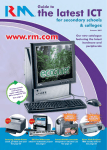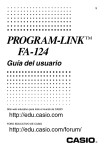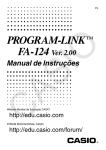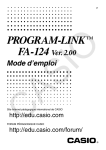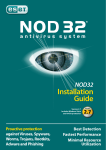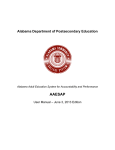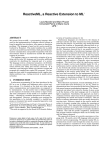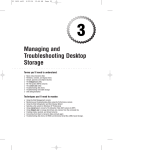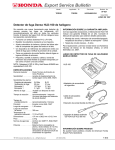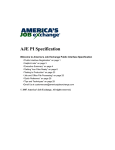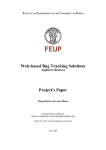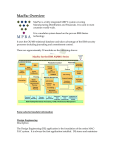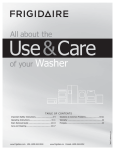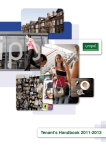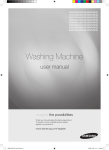Download Preparing for the WorkKeys® Assessments
Transcript
Preparing for the WorkKeys Assessments ® © 2006 by ACT, Inc. All rights reserved. NOTE: This booklet is covered by Federal copyright laws that prohibit the reproduction of the test questions without the express, written permission of ACT, Inc. ACT endorses the Code of Fair Testing Practices in Education and the Code of Professional Responsibilities in Educational Measurement, guides to the conduct of those involved in educational testing. ACT is committed to ensuring that each of its testing programs upholds the guidelines in each Code. A copy of each Code may be obtained free of charge from ACT Customer Services (68), P.O. Box 1008, Iowa City, IA 52243-1008, 319/337-1429. © 2006 by ACT, Inc. All rights reserved. Some Basic Information What is WorkKeys? The WorkKeys system from ACT is designed to help you develop better workplace skills. Better skills mean better-paying jobs—in any career field. The WorkKeys system consists of job profiling (finding out which skills are needed on the job), assessments (the tests you’ll be taking plus several others), reporting (telling you how your skills match job requirements), and instructional support (guidance to educators related to improving students’ skill levels). Why is WorkKeys important? In many places throughout the United States, employers find that students are not adequately trained even for entry-level jobs. WorkKeys helps businesses and educators work together to ensure that you leave school prepared for real jobs in the real world. What types of skills are needed? WorkKeys measures skills that employers believe are critical to job success—skills such as reading, math, listening, locating information, and teamwork. These skills are valuable for any type of occupation—skilled or professional—and at any level of education. How does the system work? WorkKeys helps you figure out how prepared you are for jobs that interest you and guides you to the education and training you need. The system documents your work skills in key areas, giving you an edge with employers when you apply for jobs. Isn’t it easy to find a job in today’s economy? There are plenty of jobs available, but employers are having a great deal of trouble finding workers with adequate skills. With the right training and experience, people can move from lowskill, low-pay jobs to high-skill, high-pay jobs. So are these tests designed for only low-level, blue-collar jobs? Not at all. WorkKeys has determined the job skills needed for more than 7,000 unique job titles, ranging from accountant to automotive technician and from welder to webmaster. In fact, the fastest growing types of WorkKeys job profiles are being done for professional, technical, and managerial jobs that require at least a bachelor’s degree. The abilities to learn, listen, communicate, work in teams, and solve problems—all areas addressed by WorkKeys—are important assets for any employee, regardless of career choice. WORKKEYS PRACTICE 1 Do higher skills mean higher salaries? Studies show that jobs requiring higher skills in math, locating information, and reading pay higher entry-level salaries. By increasing your skills while you are still in school, you increase your opportunities for higher salaries in the future. Why should I care about these tests? Since WorkKeys tests are fairly new and aren’t the college entrance exam that many high school students focus on, some students don’t see the purpose in trying to do their best on them. You need to remember, however, that everyone enters the workforce eventually—whether you get a job right out of high school, work part time while continuing your education, or go through extensive postsecondary training. WorkKeys stresses skills development important for every type of employment. Why do some of the test questions seem irrelevant to my career choice? Since WorkKeys questions relate to a variety of real-life experiences, the situations sometimes deal with work environments that do not interest particular students. Even very difficult exams, such as the Law School Admission Test or the Graduate Record Examination, routinely contain analytical reasoning questions that feature taxi drivers, executives, carpet sellers, professors, bellhops, architects, and numerous other workers. The basic skills needed to solve a legal question, configure a computer, or schedule employee vacations may be similar for all these tests. And while some WorkKeys test questions can be fairly easy, others are quite difficult—to measure the widest possible range of skills. Can I study for the tests? Since WorkKeys measures applied skills, you can’t cram to memorize answers for the tests. However, you can use these practice sets to see typical WorkKeys test questions. What happens to the test results? You can use your WorkKeys results to get a better picture of jobs you are ready for and to improve areas where your skills are weak. Employers can use the results to determine how qualified you are for positions in their organizations. And schools can use the information— along with input from employers—to ensure that their curriculum provides adequate work skills training to meet the needs of businesses. WORKKEYS PRACTICE 2 Test Taking Tips Although there are several different WorkKeys skill assessments, you will be taking only the Applied Mathematics and Reading for Information tests as part of the examination. A description of each follows. Both tests contain multiple-choice items with a question followed by five possible answers from which you are to choose the best one. The following suggestions apply to both tests. Pace yourself. The time limits set for each WorkKeys test give nearly everyone enough time to finish all the questions. However, it is important to pace yourself. Don’t spend too much time on one problem or reading section; go on to the other questions and come back if there is time. Listen to and read the directions for each test carefully. Before you begin taking one of the WorkKeys tests, pay careful attention to the directions. These tests ask for the best answer. It is important to keep this in mind when answering the questions, since it will sometimes be possible to think of responses that would be better than any of those offered or to defend a choice as not entirely wrong. Best-response formats are consistent with the real world, where choosing among less-than-perfect alternatives is routine. You may want to work out the answer you feel is correct and look for it among the choices given. If your answer is not among the choices provided, reread the question and consider all of the answer choices again to find the best one. Read each question carefully. It is important that you understand what each question asks. Some questions will require you to go through several steps to find the best answer, while others can be answered more quickly. Answer the easy questions first. The best strategy for taking a test is to answer the easy questions and skip the questions you find difficult. After answering all of the easy questions, go back and try to answer the more difficult questions. WORKKEYS PRACTICE 3 Use logic in more difficult questions. When you return to the more difficult questions, try to use logic to eliminate incorrect answers to a question. Compare the answer choices to each other and note how they differ. Such differences may provide clues as to what the question requires. Eliminate as many incorrect answers as you can, then make an educated guess from the remaining answers. Answer every question. Your score on the WorkKeys tests will be based on the number of questions that you answer correctly; there is no penalty for guessing. Thus, you should answer every question within the time allowed for each test, even if you have to guess. The test administrator will announce when there are five minutes remaining on each test. Review your work. If there is time left after you have answered every question on a test, go back and check your work on that test. Check to be sure that you marked only one answer to each question. You will not be allowed to go back to any other test or mark answers to a test after time has been called on that test. Be precise in marking your answer document. Be sure that you fill in the correct circles on your answer document. Check to be sure that the number for the line of circles on your answer document is the same as the number for the question you are answering. Position your answer document next to your test booklet so you can mark your answers quickly and completely. Erase completely. If you want to change an answer on your answer document, be sure to erase the unintended mark completely. WORKKEYS PRACTICE 4 WorkKeys Applied Mathematics Assessment Applied Mathematics is skill in applying mathematical reasoning and problem-solving techniques to work-related problems. Solving mathematical problems in the workplace can differ from solving problems in the classroom. While the math skills needed are the same, math problems in the workplace are not usually laid out neatly in a textbook format. Instead, the employee may be responsible for identifying and locating the necessary information (e.g., on a cash register, price tag, or catalog) and for knowing what to do with that information. It is, therefore, critical to strengthen your core mathematics skills and to develop your problem-solving strategies. Individuals possessing these Applied Mathematics skills will be able to successfully tackle new situations involving mathematics problems in the workplace. A formula sheet that includes all formulas required for the assessment is provided. There are five levels in the Applied Mathematics skill scale, ranging from Level 3, the least complex, to Level 7, the most complex. These levels were developed based on two main criteria: • the types of mathematical operations employees must perform, and • the form and order in which employees receive the information; that is, the presentation of the information. The skills at the lowest level involve using whole numbers and some decimals in basic math operations: addition, subtraction, multiplication, and division. As the levels progress, the math operations involve more steps. Furthermore, they include decimals and fractions, conversion of units, averaging, calculating area and volume, and ratios. As the complexity of the levels increases, the presentation of the information becomes more of a barrier to problem solving. The wording becomes ambiguous, the presence of unnecessary information is more likely, and pertinent information is less obvious. Regardless of skill level, most of these problems will involve one or more of the following applications: Quantity Employees often need to determine the number of items sold, produced, or purchased, or to figure totals on a per unit basis. Money Working with monetary units is a central part of business and relates to virtually every job, if in no other way than to understanding a paycheck. Tasks involving monetary units include figuring sales, costs, wages, and expenses. WORKKEYS PRACTICE 5 Time Some tasks involve figuring elapsed time. Other problems are also frequently figured in terms of time (e.g., production, sales, costs, distance, area). In many of these tasks, employees must be familiar with conversion of time units. Measurement Calculating distance, area, weight, and volume is crucial to most work situations. Again, employees must be familiar with conversions, as well as the appropriate degree of accuracy needed for different situations. Proportions and Percentages Proportions can be used in many tasks that require making predictions (e.g., if this is the amount for X units, how much is needed for Y units). Percentages are used in the workplace to calculate commissions, discounts, taxes, price increases, changes in sales, and wage changes. Averages Many records in the workplace are expressed in terms of averages (e.g., those involving sales records, wages, costs, hours worked). These averages become tools in the decision-making processes of the business. Many math problems found in the workplace combine two or more applications: What quantity can be produced in a specified time? What distance can be traveled in a particular time? What is the average cost in terms of money? A common combination of applications is finding the best deal, which requires employees to perform various calculations and then compare the results in terms of relative cost. Examples of typical problems are found in the WorkKeys Applied Mathematics Practice Set. Calculators WorkKeys recommends the use of calculators for the Applied Mathematics test. No problem on the test requires the use of a calculator; however, it is generally to your advantage to use one. • If you regularly use one in class or when doing your homework, it makes sense to use one on the test. But if you aren’t comfortable using a calculator, you may decide not to use one on the test. You can always bring one and decide not to use it. Pack it the night before so you won’t forget it in the morning. • We recommend that you use a calculator that you are used to—as long as it is not one of the kinds that are not permitted. Using a more powerful calculator that you are not familiar with is unlikely to give you an advantage over the kind you normally use. • You may use any four-function, scientific, or graphing calculator, unless it has features described in the Prohibited Calculators list. For models on the Calculators Permitted with Modification list, you will be required to modify some of the calculator’s features. WORKKEYS PRACTICE 6 Prohibited Calculators • These types of calculators are prohibited: pocket organizers handheld or laptop computers electronic writing pads or pen-input devices—The Sharp EL 9600 is permitted. calculators built into cellular phones or other electronic communication devices calculators with a typewriter keypad (keys in QWERTY format)—Calculators with letter keys not in QWERTY format are permitted. calculators with built-in computer algebra systems—Prohibited calculators in this category include: Casio: Algebra fx 2.0, ClassPad 300, and all model numbers that begin with CFX-9970G Texas Instruments: All model numbers that begin with TI-89 and TI-92 Hewlett-Packard: hp 48GII and all model numbers that begin with hp 40G or hp 49G Calculators Permitted with Modification • These types of calculators are permitted, but only after they are modified as noted: calculators with paper tapes: Remove the tape. calculators that make noise: Turn off the sound. calculators that can communicate wirelessly with other calculators: Completely cover the infrared data port with heavy opaque material, such as duct tape or electrician’s tape (includes Hewlett-Packard HP-38G series and HP-48G). calculators that have power cords: Remove all power/electrical cords. • If you plan to use a calculator, you must bring one with you to the test. You can’t share calculators and the test supervisor will not lend you one. • Make sure your calculator works properly. Bring a spare calculator or extra batteries, if you wish. Test supervisors will not have extra batteries or calculators. • You may use a calculator only for the Applied Mathematics test. • If you bring a calculator, the test supervisor will make sure that you: use an acceptable type of calculator use your backup calculator only if your primary calculator fails do not share your calculator with any other test taker do not store test materials in your calculator’s memory • If your calculator has large characters (one-inch high or larger) or a raised display, the supervisor may assign you to a seat where no other test taker can see your calculator. WORKKEYS PRACTICE 7 WORKKEYS PRACTICE 8 WorkKeys Applied Mathematics Practice Set This practice set can help you understand the WorkKeys Applied Mathematics skill levels and give you practice for the actual WorkKeys assessment. However, remember that this practice set is not a fulllength test and your score is not a substitute for the actual WorkKeys test score. The actual test consists of 33 problems and has a time limit of 45 minutes. The WorkKeys Applied Mathematics assessment measures skill in applying mathematical reasoning to work-related problems. The test involves setting up and solving the types of problems and doing the types of calculations that actually occur in the workplace. It is designed to be taken with a calculator and a formula sheet, as both would be available on the job. There are five skill levels, ranging from Level 3 to Level 7. As you move from Level 3 to Level 7, the mathematical concepts and calculations become more complex. WORKKEYS PRACTICE 9 Applied Mathematics Formula Sheet Distance 1 foot = 12 inches 1 yard = 3 feet 1 mile = 5,280 feet 1 mile ≈ 1.61 kilometers 1 inch = 2.54 centimeters 1 foot = 0.3048 meters 1 meter = 1,000 millimeters 1 meter = 100 centimeters 1 kilometer = 1,000 meters 1 kilometer ≈ 0.62 miles Rectangle perimeter = 2(length + width) area = length × width Rectangular Solid (Box) volume = length × width × height Cube volume = (length of side) 3 Triangle sum of angles = 180° area = 12 (base × height ) Area 1 square foot = 144 square inches 1 square yard = 9 square feet 1 acre = 43,560 square feet Circle number of degrees in a circle = 360° circumference ≈ 3.14 × diameter area ≈ 3.14 × (radius ) 2 Volume 1 cup = 8 fluid ounces 1 quart = 4 cups 1 gallon = 4 quarts 1 gallon = 231 cubic inches 1 liter ≈ 0.264 gallons 1 cubic foot = 1,728 cubic inches 1 cubic yard = 27 cubic feet 1 board foot = 1 inch by 12 inches by 12 inches Cylinder volume ≈ 3.14 × (radius ) 2 × height Cone volume ≈ Weight/Mass 1 ounce ≈ 28.350 grams 1 pound = 16 ounces 1 pound ≈ 453.592 grams 1 milligram = 0.001 grams 1 kilogram = 1,000 grams 1 kilogram ≈ 2.2 pounds 1 ton = 2,000 pounds 3.14 × (radius ) 2 × height 3 Sphere (Ball) volume ≈ 4 3 × 3.14 × (radius ) 3 Electricity 1 kilowatt-hour = 1,000 watt-hours amps = watts ÷ volts Temperature °C = 0.56 (°F - 32) or 5 9 (°F - 32) °F = 1.8 (°C) + 32 or ( 95 × °C) + 32 NOTE: Problems on the WorkKeys Applied Mathematics assessment should be worked using the formulas and conversions on this formula sheet. WORKKEYS PRACTICE 10 Applied Mathematics Level 3 Individuals with Level 3 skills can set up and solve problems with a single type of mathematical operation (addition, subtraction, multiplication, or division) on whole numbers, fractions, decimals, or percentages. 1. You work at a fruit market. Bananas cost 50¢ a pound. A customer hands you a bunch of bananas that weighs 3 pounds. How much should you charge for the bunch of bananas? A. B. C. D. E. $0.17 $0.50 $0.53 $1.50 $3.50 2. To make curtains for a living room window for a customer, you will need 3 pieces of fabric in the following lengths: 3 feet, 3 feet, and 5 feet. What is the total length of fabric you will need? A. B. C. D. E. 08 feet 11 feet 14 feet 30 feet 45 feet 3. You sell pies at a farmers’ market for $7.50 each. A group of 5 kids wants to pitch in equally to share one of your pies. How much will each of them need to pay to buy a whole pie together? A. B. C. D. E. $0.75 $1.50 $2.50 $3.75 $7.50 WORKKEYS PRACTICE 11 Applied Mathematics Level 4 Individuals with Level 4 skills can set up and solve problems with one or two different mathematical operations (addition, subtraction, multiplication, or division) on whole numbers, fractions, decimals, or percentages. 1. You are a receptionist at a doctor’s office. A patient’s bill for a checkup totals $85.00. The patient’s health insurance requires the patient to pay 20% of the total bill. How much should the patient pay for the checkup? A. B. C. D. E. $04.25 $08.50 $17.00 $42.50 $68.00 2. You are scheduling a new delivery route and you need to find out how long it will take a driver to complete the route. You start the route at 9:50 A.M. and finish at 2:05 P.M. How long does it take to drive the route? A. B. C. D. E. 4 hours 15 minutes 4 hours 55 minutes 5 hours 15 minutes 5 hours 45 minutes 7 hours 45 minutes 3. As a bowling instructor, you calculate your bowlers’ averages during tournaments. In 5 games, one bowler had the following scores: 143, 156, 172, 133, and 167. What was that bowler’s average? A. B. C. D. E. 147 153 154 156 161 WORKKEYS PRACTICE 12 Applied Mathematics Level 5 Individuals with Level 5 skills can set up and solve problems with several steps of logic and calculation involving a mixture of whole numbers, fractions, decimals, or percentages. 1. As a laboratory assistant, you measure chemicals using the metric system. For your current research, you need to measure out 45 grams of sodium chloride. The bottle you are using lists the amount in ounces. About how many ounces of sodium chloride will you need? A. B. C. D. E. 000 0.1 000 1.6 00 28.4 0 720.0 1,275.8 2. You are making a welding fixture and must cut down a length of steel tubing from 19 3 8 inches to 1 16 9 16 11 inches. When you cut the tubing, you will waste inch of it because of the width of the saw cut. If the leftover piece is long enough, you will use it in another fixture. How long will this leftover piece be? A. 7 34 B. 13 7 16 C. 7 78 D. 8 14 E. 8 34 3. You are doing marketing research to find out the purchasing potential of students in the community. Based on the latest census, there are 9,860 students in a population of 62,400 people. What percent of the total population do students make up? A. B. C. D. E. 06.3 07.3 15.8 52.5 84.2 WORKKEYS PRACTICE 13 Applied Mathematics Level 6 Individuals with Level 6 skills can set up and solve problems containing unnecessary information and requiring multiple steps. Calculations involve a mixture of whole numbers, fractions, decimals, or percentages. 1. You are a school photographer taking individual and class pictures for 2 classes of 21 students each. On average, each individual picture takes 3 minutes and a class picture takes 10 minutes. About how long should it take you to get all of the pictures? A. B. C. D. E. 1 hour00 3 minutes 1 hour 013 minutes 2 hours 06 minutes 2 hours 16 minutes 2 hours 26 minutes 2. You are applying fertilizer to a football field. The field is 360 feet long and 160 feet wide. You use 8 pounds of fertilizer per 1,000 square feet. The fertilizer comes in 50-pound bags. How many bags of fertilizer will you need to complete the job? A. B. C. D. E. 06 07 08 09 10 3. At Appliance City you sold a refrigerator to a customer for $369.00. Appliance City advertises that if a customer finds the same refrigerator anywhere else for a lower price, you will give a refund equal to 150% of the price difference. The customer returns with a Kitchen Stuff Inc. ad that shows the same refrigerator for $335.00. After you give the advertised refund to the customer, what is the customer’s final cost? A. B. C. D. E. $051.00 $219.00 $318.00 $335.00 $364.00 WORKKEYS PRACTICE 14 Applied Mathematics Level 7 Individuals with Level 7 skills can set up and solve complex problems requiring extensive calculations. They can calculate rate of change, set up and manipulate complex ratios and proportions, find multiple areas or volumes of two- and three-dimensional shapes, find the best economic value of several alternatives, and locate errors in multiple-step calculations. 1. You are an urban planner assessing the growth of a city. Ten years ago, the city’s population was 249,583. Its current population is 318,270. By about what percentage has the city grown over the past ten years? A. B. C. D. E. 13% 22% 28% 69% 78% 2. You are comparing prices from 2 office supply stores. Your office needs 5 cases of blue paper. Home & Office Headquarters lists a case of paper at $25.85 with a 10% discount on an order of 5 cases or more. Office Supplies R Us lists a case of paper at $27.36 with a 15% discount on 5 cases or more. Delivery costs from Home & Office Headquarters are $2.50 per case. Office Supplies R Us will deliver for $10 an order. What is the least amount that you would have to spend for the paper? A. B. C. D. E. $023.26 $033.26 $071.80 $126.28 $141.75 3. To complete adjustable bookshelves, a customer at your store needs to purchase shelf standards to attach to the wall. The customer wants the shelving to be 9 feet high and 10 feet wide. The shelf standards come in 48-inch and 60-inch sections. The 48-inch sections cost $12.95; the 60-inch sections cost $16.95. The standards should be placed 1 foot from each end of a shelf and no more than 24 inches apart. Before tax is added, what will be the total cost of the shelf standards the customer will need? shelf standard A. B. C. D. E. $089.70 $119.60 $129.50 $149.50 $179.40 WORKKEYS PRACTICE 15 An Important Consideration about the Answers to the Practice Sets Some WorkKeys questions have a response choice (the “key”) that can be clearly defined as right or correct and other response choices (the “distractors” or “foils”) that can be identified as wrong or incorrect. Many WorkKeys questions, however, are in a bestresponse format: the keyed response is simply the best of those available. It is important to keep this in mind when discussing such questions, since it will sometimes be possible to think of responses that would be better than any of those offered, or to defend a distractor as not entirely wrong. Best-response formats are consistent with the real world, where choices among less-than-perfect alternatives are routinely the case. Note: The solutions shown indicate one or two ways to solve each problem. There may be other, equally valid methods of solving the problems. Answers to Applied Mathematics Level 3 Practice Set Answer to Level 3 Sample Item 1: Multiply the cost per pound by the number of pounds to find the total cost. Incorrect: 50 ÷ 3 = 16.67¢ = $0.1667, rounded up to $0.17 (divided instead of multiplying) Incorrect: 50 × 1 = 0.50 (cost of 1 pound of bananas, not 3) Incorrect: 50 + 3 = 0.53 (added instead of multiplying) Correct: 50¢ (cost per pound) × 3 (pounds of bananas) = 150¢ = $1.50 (total cost of bananas) E. Incorrect: 3 pounds, 50 Æ 3.50 (just put the numbers from the problem together without doing the math) A. B. C. D. Answer to Level 3 Sample Item 2: Add the three lengths together to find the total length. A. Incorrect: 3 + 5 = 8 (added only two of the three lengths) B. Correct: 3 feet + 3 feet + 5 feet = 11 feet C. Incorrect: (3 × 3) + 5 = 14 (multiplied the first two lengths instead of adding, then added the third length) or (3 + 3 + 5) + 3 = 14 (added the number of pieces of fabric to the lengths of those pieces) D. Incorrect: (3 + 3) × 5 = 30 (added the first two lengths but then multiplied by the third length instead of adding) E. Incorrect: (3 × 3) × 5 = 45 (multiplied all of the numbers instead of adding) WORKKEYS PRACTICE 16 Answer to Level 3 Sample Item 3: Divide the cost of an item by the number of persons paying for it to determine how much each person should pay. A. Incorrect: 7.50 ÷ 10 or 7.50 with the decimal place changed = 0.75 (divided by 10 instead of 5 or simply changed the decimal place of the cost of the whole pie) B. Correct: $7.50 per pie ÷ 5 kids pitching in for the pie = $1.50 to be paid by each member of the group C. Incorrect: 7.50 – 5 or 7.50 ÷ 3 = 2.50 (subtracted 5 from the cost of a whole pie instead of dividing by 5 or divided by 3 instead of 5) D. Incorrect: 7.50 ÷ 2 = 3.75 or 7.50 × 5 = 37.50 Æ 3.75 (divided by 2 instead of 5 or multiplied by 5 instead of dividing and shifted the decimal) E. Incorrect: 7.50 ÷ 1 = 7.50 (total amount needed to buy a whole pie) WORKKEYS PRACTICE 17 Answers to Applied Mathematics Level 4 Practice Set Answer to Level 4 Sample Item 1: Multiply the patient’s bill of $85.00 by 20% (0.20) to find the amount the patient needs to pay. A. Incorrect: 85 ÷ 20 = 4.25 (divided the charges by 20 instead of multiplying by 0.20) B. Incorrect: 85 ÷ 10 or 85 × 0.10 = 8.50 (divided the charges by 10 or multiplied by 0.10 instead of multiplying by 0.20) C. Correct: $85 (total bill) × 0.20 (% copay) = $17.00 D. Incorrect: 85 ÷ 2 = 42.50 (divided the charges by 2 instead of multiplying by 0.20) E. Incorrect: 85 × 0.80 = 68.00 (calculated the insurance company’s portion instead of the patient’s) Answer to Level 4 Sample Item 2: Change the times to correspond to the 24-hour clock by adding 12 to the P.M. time, then subtract the starting time from the ending time. A. Correct: (2:05 P.M. – 9:50 A.M.) = (14 hours 5 minutes – 9 hours 50 minutes) = (13 hours 65 minutes – 9 hours 50 minutes) = 4 hours 15 minutes B. Incorrect: (2:05 P.M. – 9:50 A.M.) = (14 hours 5 minutes – 9 hours 50 minutes) = (13 hours 105 minutes – 9 hours 50 minutes) = 4 hours 55 minutes (borrowed one hour but added 100 minutes) C. Incorrect: (2:05 P.M. – 9:50 A.M.) = (14 hours 5 minutes – 9 hours 50 minutes) = (14 hours 65 minutes – 9 hours 50 minutes) = 5 hours 15 minutes (added 60 minutes but forgot to subtract one hour) D. Incorrect: (2:05 P.M. – 9:50 A.M.) = (14 hours 5 minutes – 9 hours 50 minutes) = 5 hours 45 minutes (subtracted the minutes the wrong way) E. Incorrect: (9:50 – 2:05) = (9 hours 50 minutes – 2 hours 5 minutes) = 7 hours 45 minutes (ignored the A.M. and P.M. and subtracted the times given the wrong way) Answer to Level 4 Sample Item 3: Add the five scores together and divide by 5 to find the bowler’s average. A. Incorrect: (133 × 172) ÷ 156 = 146.6, rounded up to 147 (multiplied the low score by the high score, then divided by the median score) B. Incorrect: (133 + 172) ÷ 2 = 152.5, rounded up to 153 (added the low and high scores, then divided by 2) C. Correct: (143 + 156 + 172 + 133 + 167) ÷ 5 = 154.2, rounded down to 154 D. Incorrect: 156 is the median of the 5 scores (2 numbers below, 2 numbers above) E. Incorrect: (143 + 172 + 167) ÷ 3 = 160.7, rounded up to 161 (added the first, third, and fifth scores, then divided by 3) WORKKEYS PRACTICE 18 Answers to Applied Mathematics Level 5 Practice Set Answer to Level 5 Sample Item 1: Using the value given on the formula sheet, divide the number of grams by the number of grams per ounce to find the number of ounces needed. A. Incorrect: 45 ÷ 453.592 = 0.099208, rounded up to 0.1 (divided by the number of grams/pound instead of the number of grams/ounce) B. Correct: 45 grams ÷ 28.350 grams/ounce = 1.58730, rounded up to 1.6 ounces C. Incorrect: Approximate number of grams/ounce (28.350 on the formula sheet, rounded up to 28.4; no calculation was done on the amount given in the problem) D. Incorrect: 45 × 16 = 720.0 (multiplied by the number of ounces/pound instead of dividing by the number of grams/ounce) E. Incorrect: 45 × 28.350 = 1,275.75, rounded up to 1,275.8 (multiplied by the number of grams/ounce instead of dividing) Answer to Level 5 Sample Item 2: Subtract the new length as well as the width of the saw cut from the total length to get the length of the leftover piece. 3 8 19 83 A. Correct: 19 – 11 169 – 1 16 = 19 166 – 11 169 – 1 16 = 18 22 16 – 11 169 – 1 16 = 7 12 16 = 7 3 4 13 22 B. Incorrect: – 11 169 = 19 166 – 11 169 = 18 16 – 11 169 = 7 16 (didn’t account for the saw cut width) 22 C. Incorrect: 19 83 – (11 169 – 161 ) = 19 166 – (11 169 – 161 ) = 18 16 – 11 186 = 7 11 46 = 7 78 (subtracted the saw cut from the piece cut instead of the total length) 6 4 D. Incorrect: 19 83 – 11 169 – 161 = (19 – 11) + ( 169 + 161 – 83 ) = (19 – 11) + ( 10 16 – 1 6 ) = 8 1 6 = 8 1 4 (wrong order of fractions) E. Incorrect: 19 83 – 11 169 = (19 – 11) + and the denominator) 9−3 16 − 8 =8 6 8 =8 3 4 (subtracted in both the numerator Answer to Level 5 Sample Item 3: Divide the number of students by the total population, then multiply by 100 to find the percentage of students in the total population. A. Incorrect: 62,400 ÷ 9,860 = 6.3 (divided the wrong way and did not change to a percent) B. Incorrect: (62,400 + 9,860) ÷ 9,860 = 7.3 (added students to the total population, then divided by the number of students) C. Correct: 9,860 ÷ 62,400 × 100 = 15.8% (the number of students divided by the total number of people multiplied by 100 to get a percentage) D. Incorrect: (62,400 – 9,860) ÷ 1,000 = 52.5 (subtracted the number of students from the total population, then divided by 1,000 to make the answer seem reasonable) E. Incorrect: (62,400 – 9,860) ÷ 62,400 × 100 = 84.2 (found the percent of nonstudents) WORKKEYS PRACTICE 19 Answers to Applied Mathematics Level 6 Practice Set Answer to Level 6 Sample Item 1: Multiply the number of students per class by the number of minutes per student for each individual picture, then multiply by the number of classes. To this, add the number of classes times the number of minutes per class picture. Finally, change minutes to hours and minutes. A. Incorrect: 21 × 3 = 63 = 1 hour 3 minutes (calculated only the time needed to take individual pictures for one of the classes) B. Incorrect: (21 × 3) + 10 = 73 = 1 hour 13 minutes (calculated only the time needed to take individual pictures and one class picture) C. Incorrect: (21 × 3) × 2 = 126 = 2 hours 6 minutes (calculated only the time needed to take individual pictures for the two classes) D. Incorrect: (21 × 3) × 2 + 10 = 136 = 2 hours 16 minutes (calculated the time needed to take individual pictures for the two classes and only one class picture) E. Correct: (21 students/class × 3 minutes/student picture) × 2 classes + (2 classes × 10 minutes/class picture) = 146 minutes = 2 hours 26 minutes Answer to Level 6 Sample Item 2: Multiply the length of the field by the width to find the area. Multiply the area by the number of pounds of fertilizer divided by 1,000 square feet. Divide the number of pounds by the number of pounds per bag to get the number of bags of fertilizer needed. A. Incorrect: 360 ÷ 160 ÷ 8 × 1,000 ÷ 50 = 5.6, rounded up to 6 (divided the dimensions of the field instead of multiplying, divided instead of multiplying by 8, multiplied instead of dividing by 1,000, then divided by 50) B. Incorrect: 360 × 160 ÷ 8 ÷ 1,000 = 7.2, rounded down to 7 (divided the area of the field by pounds of fertilizer per 1,000 square feet instead of multiplying, then divided by 1,000 square feet; didn’t factor in the 50-pound bags) C. Incorrect: 360 × 160 ÷ 1,000 – 50 = 7.6, rounded up to 8 (divided the area of the field by 1,000 square feet, then subtracted 50 instead of dividing by 50, and didn’t factor in 8 pounds/1,000 square feet, or just chose 8 because it appears in the problem) D. Incorrect: (360 × 160) × 8 ÷ 1,000 ÷ 50 = 9.2, rounded down to 9 (calculated correctly, but rounded down instead of up, which would not give enough to cover the whole field) E. Correct: 360 feet × 160 feet = 57,600 square feet; 57,600 square feet × 8 pounds of fertilizer ÷ 1,000 square feet = 460.8 pounds of fertilizer; 460.8 pounds ÷ 50 pounds/bag = 9.216, rounded up to 10 bags needed WORKKEYS PRACTICE 20 Answer to Level 6 Sample Item 3: Subtract the lesser price from what the customer paid in order to find the difference. Multiply the difference by 150% (1.50), then subtract this refund amount from what the customer originally paid to find the final cost of the refrigerator. A. Incorrect: (369 – 335) × 1.50 = 51 (just found the refund amount) B. Incorrect: 369 – 150 = 219 (the percent was used as a dollar amount and subtracted from the amount paid) C. Correct: $369.00 – [($369.00 – $335.00) × 1.50] = $318.00 D. Incorrect: 369 – (369 – 335) = 335 (used the lower price, or subtracted the difference in prices from the price paid) E. Incorrect: 369 – [(369 – 335) × 0.15] = 363.90, rounded up to 364 (changed the percent to a decimal by dividing by 1,000 instead of 100) WORKKEYS PRACTICE 21 Answers to Applied Mathematics Level 7 Practice Set Answer to Level 7 Sample Item 1: Subtract the previous population from the current population to find the increase in population. Divide the increase by the previous population, then multiply this number by 100 to get a percentage. A. Incorrect: 318,270 ÷ 249,583 = 1.275; 1.275 × 10 = 12.75, rounded up to 13 (divided the current population by the previous population instead of subtracting, then moved the decimal on the result by multiplying by 10 instead of 100) B. Incorrect: 318,270 – 249,583 = 68,687; 68,687 ÷ 318,270 = 0.216; 0.216 × 100 = 21.6, rounded up to 22 (divided the difference between the previous and current populations by the current population instead of the previous population) C. Correct: 318,270 – 249,583 = 68,687; 68,687 ÷ 249,583 = 0.275; 0.275 × 100 = 27.5%, rounded up to 28% D. Incorrect: 318,270 – 249,583 = 68,687; 68,687 ÷ 1,000 = 68.7, rounded up to 69 (subtracted the previous population from the current population, then divided the result by 1,000 instead of the previous population to get a percentage) E. Incorrect: 249,583 ÷ 318,270 = 0.784; 0.784 × 100 = 78.4, rounded down to 78 (divided the previous population by the current population instead of subtracting the previous population from the current population, then multiplied by 100 to get a percentage) Answer to Level 7 Sample Item 2: Multiply the price of one case by the discount rate (divided by 100 to convert to a decimal). Subtract the discount amount from the price of one case and multiply by the number of cases. Add the cost of delivery to get the final cost. Do this for both companies and choose the smaller (underlined) total. A. Incorrect: $25.85 – ($25.85 × 0.10) = $23.27 or $27.36 – ($27.36 × 0.15) = $23.26 (the price for one case with the discount instead of the price for five cases; forgot the delivery charge) B. Incorrect: $25.85 – ($25.85 × 0.10) + (5 × $2.50) = $35.77 or $27.36 – ($27.36 × 0.15) + $10 = $33.26 (calculated the price for one case with the discount instead of five cases) C. Incorrect: 5 × ($25.85 – 10) + (5 × $2.50) = $91.75 or 5 × ($27.36 – 15) + $10 = $71.80 (used the percentage discount as a dollar amount) D. Correct: 5 × [$25.85 – ($25.85 × 0.10)] + (5 × $2.50) = $128.83 for the first store; 5 × [$27.36 – ($27.36 × 0.15)] + $10 = $126.28 for the second store E. Incorrect: 5 × ($25.85 + $2.50) = $141.75 or (5 × $27.36) + $10 = 146.80 (did not calculate the discounts) WORKKEYS PRACTICE 22 Answer to Level 7 Sample Item 3: Determine which shelf standards are needed to give a height of 9 feet (one of each size makes one set). Determine how many sets of standards are needed to support the 10-foot shelves (standards are needed at the 1, 3, 5, 7, and 9-foot locations along the 10-foot shelves, so 5 sets are needed.) Add the shelf standard prices together to get the price of one set and multiply by the number of sets needed. A. Incorrect: 48 inches = 4 feet; 60 inches = 5 feet; 4 feet + 5 feet = 9-foot height needed; (12.95 + 16.95) × 3 = 89.70 (calculated the cost of 3 sets of standards when 5 are needed) B. Incorrect: 48 inches = 4 feet; 60 inches = 5 feet; 4 feet + 5 feet = 9-foot height needed; (12.95 + 16.95) × 4 = 119.60 (calculated the cost of 4 sets of standards when 5 are needed) C. Incorrect: 48 inches = 4 feet; 4 feet × 2.5 standards = 10 feet; 12.95 × 2.5 × 4 = 129.50 (calculated the cost for 2 12 48-inch sections [giving a height of 10 feet instead of 9 feet] × 4 sets of standards instead of 5 sets of one standard of each length) D. Correct: 48 inches = 4 feet; 60 inches = 5 feet; 4 feet + 5 feet = 9-foot height needed for each set; ($12.95 + $16.95)/set × 5 sets = $149.50 E. Incorrect: 48 inches = 4 feet; 60 inches = 5 feet; 4 feet + 5 feet = 9-foot height needed; (12.95 + 16.95) × 6 = 179.40 (calculated the cost of 6 sets of standards when only 5 are needed) WORKKEYS PRACTICE 23 WORKKEYS PRACTICE 24 WorkKeys Reading for Information Assessment Reading for Information is skill in reading and understanding work-related instructions and policies. Such material, known as procedural text, differs from the explanatory and narrative text on which most reading programs are based. In addition, unlike reading and content-area texts, which are usually organized to make the reading easy to understand, workplace communication is not necessarily designed to be easy to read. It may even be poorly or unclearly written. These differences can be drawbacks for many employees when reading and understanding much of the material they encounter on the job. There are five levels in the Reading for Information skill scale, and the skills included can be loosely grouped into four categories: Choosing Main Ideas or Details This requires skill at selecting the important information and supporting details from a written document. Looking for main ideas and details is a common reading task. But, as mentioned previously, reading texts encountered in the workplace differ from the selections most often used in reading programs. In such programs, the main idea is generally found in the topic sentence at the beginning of a paragraph or occasionally in a concluding sentence. However, written communication found in the workplace is often not constructed in such an organized manner. Consequently, the employee needs to be able to use clues other than placement to identify the main ideas and important details. Understanding Word Meanings Although some basic vocabulary is involved in this skill area, the emphasis is on using context to determine specific word meanings. The demands of the workplace progress from the need to know simple words and identify definitions clearly stated in the reading to the need to use the context to determine the meanings of more difficult words. Jargon, technical terminology, and words with multiple meanings are used increasingly as the contexts become more complex. Applying Instructions Conveying instructions is the principal purpose of a great deal of workplace communication. Skill in applying instructions involves sequencing and generalizing. As in the other skill areas, the workplace requirements range from the simple to the more complex. As the levels increase, the instructions contain more steps and conditionals are added. At the lower levels, employees need only apply instructions to clearly described situations; at the higher levels, employees must apply instructions to less similar and, eventually, to new situations. Applying Information and Reasoning Often, for effective performance of a task, it is necessary for employees to apply information given in workplace communications to similar or new situations, to predict consequences of certain actions, and to understand the reasoning, which may or may not be stated, behind a policy. As in the previous category, employees may be asked to apply information and reasoning to clearly described situations at the lower levels, while, at higher levels, they must apply information and reasoning to similar and then to new situations. This practice set gives examples of the reading materials and questions on the WorkKeys Reading for Information test. WORKKEYS PRACTICE 25 WorkKeys Reading for Information Practice Set This practice set can help you understand the WorkKeys skill levels and give you practice for the actual WorkKeys assessment. However, remember that this practice set is not a full-length test and your score is not a substitute for the actual WorkKeys test score. The actual test consists of 33 questions and has a time limit of 45 minutes. Several questions may be grouped together and relate to a single piece of reading material. WorkKeys Reading for Information is the skill people use when they read and use written text in order to do a job. The written texts include memos, letters, directions, signs, notices, bulletins, policies, and regulations. It is often the case that workplace communications are not necessarily well-written or targeted to the appropriate audience. Reading for Information materials do not include information that is presented graphically, such as in charts, forms, or blueprints. There are five skill levels, from Level 3 to Level 7. As you move from Level 3 to Level 7, both the materials and the tasks become more complex. WORKKEYS PRACTICE 26 Reading for Information Level 3 Individuals with Level 3 skills understand basic words and can identify main ideas. They understand when to follow each step in a set of instructions and can apply the instructions to situations that are the same as the one they are reading about. Level 3 materials include simple instructions, company policies, and announcements. They are short and straightforward, and contain basic vocabulary. MARCO Industries To: Fr: Re: 14428 Del Rio San Diego, CA All Employees President's Office Holiday Closing The past year has been a good one for MARCO Industries. Our sales are way up. I believe that there will be more orders for our products in the new year, too. All of you have worked very hard and should be rewarded. So I have decided to close MARCO Industries from December 24 through January 2. All employees will get a paid vacation during that time. This vacation will not count against your regular paid vacation time. It is a bonus. Simply write "holiday leave" on your time sheets for those dates. 1. Based on this memo, what should you write on your time sheet for December 24 though January 2? A. B. C. D. E. Bonus sales Holiday leave Industry closed Paid vacation Regular vacation WORKKEYS PRACTICE 27 CLEANROOM PRACTICES YOU MAY NOT USE ANY COSMETICS IN THE CLEANROOM. YOU MUST CLEAN OFF FACE POWDER, EYE SHADOW, MASCARA, AND LIPSTICK. NON-OIL-BASED LOTIONS ARE ACCEPTABLE BUT SHOULD BE APPLIED BEFORE ENTERING THE MAIN AREA. TO PREVENT CONTAMINATION OF PRODUCT, NO COLOGNE, PERFUME, HAIR SPRAY, HAIR GEL, OR FINGERNAIL POLISH MAY BE WORN. FINGERNAILS MUST NOT GO MORE THAN 0.25 INCH PAST THE FINGERTIPS AND CANNOT PUNCH THROUGH GLOVES. THE ONLY METAL ORNAMENT ALLOWED INSIDE THE CLEANROOM IS A WEDDING BAND (WRIST WATCHES ARE NOT ALLOWED). IF THE WEDDING BAND IS NOT SMOOTH, NYLON GLOVES MUST BE WORN UNDER VINYL GLOVES. 2. What type of product can you have in the cleanroom? A. B. C. D. E. Face powder Fingernail polish Hair spray Mild cologne Non-oil-based lotions WORKKEYS PRACTICE 28 H ar m e d h t u Department Store Housewares Department All items in stock must have a sample displayed. The samples must have a scannable bar code on the bottom. Put a hanging price tag on all samples with the regular price displayed. Sale prices should be displayed on a yellow hangtag in a plastic jacket. Finally, post a sign with the regular price on the shelf underneath each sample item. Cookware sets must have both an eight-piece sample set and a thirteen-piece sample set for display only. Separate the boxes with the cookware sets. Boxes with eight-piece sets must be kept on the shelf above the eight-piece sample set. Boxes with thirteen-piece sets must be kept on the shelf above the thirteen-piece sample set. 3. In the department store where you work, you are asked to mark prices for an upcoming sale. If the thirteenpiece cookware set is going on sale, where should you mark the sale price? A. B. C. D. E. Beside the display on a separate sign On a yellow hangtag in a plastic jacket On the display items with a yellow marker On the regular hanging price tag Over the bar code on the bottom of the box WORKKEYS PRACTICE 29 Reading for Information Level 4 Individuals with Level 4 skills can apply instructions to situations that are the same as the situations in the reading materials. They can identify cause-effect relationships and define words by the context. Level 4 materials may include several details or describe processes involving several steps. New Policy Effective immediately, the following Company Standard for Dress will be in force at all times: Except on specially designated holidays, business dress attire will always be worn by all upper-level management due to the heavy contact these individuals have with clients and the public. This attire is limited to business suits/slacks for both women and men. However, casual dress is allowed for all middle-level employees during the core work week (Monday through Thursday). This casual dress will consist of long- or short-sleeved shirts; polo shirts; khaki pants; "dress walking shorts," hemmed at the knee level or lower; and "dress" canvas shoes. Jeans, printed T-shirts, or regular tennis shoes are not allowed on core casual dress days. Fridays have been officially declared "Jeans Day" here at our company. On Fridays, any kind of jeans are permitted (colored denims, blue jeans, etc.) However, these jeans must be in new or next-to-new condition, with no holes, writing, or other obvious "statement makers." Printed T-shirts and regular tennis shoes are still prohibited on Friday. 1. According to the policy shown, “dress walking shorts” are: A. B. C. D. E. banned if they are hemmed above the knee. banned on Friday unless they are made of colored denim. permitted on any Monday through Thursday if worn with a new printed T-shirt. permitted only on Friday and must be hemmed below the knee. permitted only on Friday if the hemline is at the knee. WORKKEYS PRACTICE 30 Cycle City ATTENTION CASHIERS: All store employees will now get 20% off all items they buy here. Please follow the new directions listed below. Selling bicycles and equipment to employees Ask to see the employee’s store identification card. Enter the employee’s department code number into the cash register. Use the cash register to take 20% off the price. Then push the sales tax button. Write your initials on the sales receipt. Sell equipment to employees during store hours only. Accepting returns from employees Employees receive a store credit certificate for items they return to the store. Store credit certificates are next to the gift certificates. Employees may not get a cash refund for items they return to the store. 2. According to the instructions shown, what is the last thing a cashier should do before pushing the sales tax button? A. B. C. D. E. Check the employee’s store identification card Check the employee’s store credit certificate Enter the cashier’s store identification number into the cash register Enter the employee’s department code number into the cash register Use the cash register to take 20% off the price WORKKEYS PRACTICE 31 Human Resources Office Acme Industries To All Employees: Our company picnic will have something new the Toddler Tent. There will be a large sandbox with buckets, shovels, etc. and a large grassy space with plastic, ride-on toys for the children. The area will be enclosed by a fence supporting a large red and white canopy, so the area will be secure and shaded. For the fun and safety of our youngest family members, be aware of these Toddler Tent rules: This area is intended for children up to about three years old. There will be a 40-inch high horizontal pole at the Toddler Tent gate. If a child fits under that pole, the child may enter and play inside. If not, then the child may enjoy all of the many other activities that are provided for the bigger kids. Parents must not leave children unattended in this area; a responsible person must be supervising each child. All common sense rules of play (no sand throwing, etc.) are to be observed. All toys are to remain inside the enclosed area. Each adult is encouraged to be kind and firm in making sure that each child obeys these rules so that our company picnic is safe and enjoyable for every family attending. If you have any questions or comments, please use the computer in your work station to send an e-mail message to [email protected]. In the plant, use the computer provided for your department. 3. Based on this memo, to make a suggestion about the Toddler Tent, an employee would need: A. B. C. D. E. the name of the picnic committee chairperson. the phone number for the Toddler Tent organizer. to attend a picnic committee meeting. to have access to a computer. to tell his or her supervisor. WORKKEYS PRACTICE 32 Reading for Information Level 5 Individuals with Level 5 skills can apply information from reading materials to new situations that are similar to those described in the materials and they can understand words and phrases with specialized or multiple meanings. Level 5 materials include company policies, procedures, and announcements. All the information in them is stated clearly and directly, but there are many details. WORKKEYS PRACTICE 33 Snowmobile Regulations & Safety Snowmobile operators must have a valid state motor vehicle driver's license in their possession. Persons possessing a learner’s permit may operate a snowmobile when supervised one-to-one within line of sight (but no more than 100 yards) by a licensed person 21 years old or older. Maximum speed limit is 45 mph (72 kph) or less where posted or as conditions warrant. Speed is checked by radar. Obey all speed limit signs and stop signs. Snowmobiles must be registered according to applicable state law. Muffler, lights, and brakes must be in good working condition. Snowmobile exhaust and muffler systems must be in good working order. The maximum noise allowed is 78 decibels when measured during full acceleration at a distance of 50 feet. Snowmobiles exceeding the decibel standard will be denied entry into the park. If bison or other wildlife are on the road, stop at least 25 yards away and/or pull your machine as far as possible to the opposite side of the road; give them a chance to get off the road. If they run toward you, and you can confidently turn around, do so and move to a safe place to reassess the situation. If they walk or run toward you, and you cannot turn around, get off your machine and stand to the side of it, keeping the machine between you and the animal(s). If they are standing calmly, inch toward them and assess their behavior. If they remain calm, pass on the opposite side of the road at a moderate speed. Do not make sudden or erratic movements; use groomed pullouts where possible. If the animal(s) appear agitated, do not attempt to pass as any advance may cause the animal(s) to charge. Do not chase animals or cause them to stampede. Adapted from: National Park Service. “Official Website of Yellowstone National Park” (see “planning a visit,” then “things to do,” “winter activities,” “rules and regulations,” and “snowmobiling”). Retrieved August 15, 2001, from http://www.nps.gov/yell/planvisit/todo/winter/snowmobile.htm 1. You are a park ranger. A person wants to enter the park riding a snowmobile that you suspect is too loud. To determine whether the snowmobile’s noise is too loud as specified by the guidelines shown, you should ask the person to: A. B. C. D. E. check the snowmobile’s decibel level at a speed of at least 25 miles per hour. demonstrate that the exhaust and muffler systems are in good working order. run the snowmobile at a speed no greater than 45 miles per hour (72 kilometers per hour). run the snowmobile at full acceleration while you test the decibel level from 50 feet away. show a driver’s license or learner’s permit and snowmobile registration. WORKKEYS PRACTICE 34 First Responder Legal and Ethical Rights Many First Responders are concerned about lawsuits. Lawsuits against those who give care at the scene of an emergency are not often successful. The First Responder's scope of practice is defined as the range of duties and skills a First Responder is allowed and expected to perform when necessary. The First Responder, like other out-of-hospital care providers, is governed by legal, ethical and medical guidelines. These guidelines establish the scope and the limits of care the first responder provides. While on duty, the First Responder has an obligation to respond to an emergency and provide care at the scene; this obligation is called a duty to act. This duty is governed either by case law, statute, or job description. This duty applies to public safety officials, certain government employees, licensed and certified professionals and medical paraprofessionals while on duty. If a First Responder sees a motor vehicle crash while driving to work, in most states he or she only has a moral obligation to stop. However, once a First Responder has begun care, he or she is legally obligated to continue providing care until care can be transferred to a person with equal or greater training. A conscious victim has a basic right to decide what can and cannot be done to his or her body. Therefore to provide care for an ill or injured person, the responder must first obtain that person's consent. Permission is implied if the victim is unconscious or is a child with a serious condition and no supervising adult present. Consequently the responder is only negligent if he or she does not respond in a professional manner or fails to act within this duty, thus causing physical injury, which can be measured in financial terms. 26 2. An off-duty First Responder stops at a construction site to help a worker who has fallen from a scaffold. According to the policy shown, the First Responder must remain on duty with the injured worker until: A. B. C. D. E. a crew member who is not a First Responder agrees to watch over the victim until help arrives. another equally or more skilled person arrives and takes over. the Responder has done everything within his or her skill limits to help the worker. the Responder must leave because of other obligations. the Responder has met his or her moral obligation. WORKKEYS PRACTICE 35 Notice of Workstation Replacement -Timing and ProceduresMaster Industries' Management Information Systems (MIS) department will undertake a firm-wide upgrade of computer workstations over the course of five weeks beginning at the first of next month. Due to the age of the existing workstations, full replacement of the hardware will occur rather than internal system modifications. This will cause some disruption in normal work and the need for care in the preservation of existing software and data. This memo is intended to outline timing and procedures for upgrade. Workstation replacement will occur on the following timetable. Week 1: Finance and Marketing departments. Week 2: Public Affairs and Human Resources departments. Week 3: Service and Customer-Relations departments. Week 4: R and D department. Week 5: Tweaking and troubleshooting in all departments. In the week prior to the week in which your department is scheduled for workstation replacement, please do the following: (1) Complete the Software Inventory Questionnaire (SIQ) sent to you with this memo, which will affirm which software packages you wish to retain when you get your new workstation, and forward the SIQ to MIS. (2) Using the File Manager software accessory currently on your workstation, copy all data that you wish to preserve from your local hard drive to the network (F) drive. MIS staff will assist you with this, if necessary, and will transfer the data back to your new local workstation after the upgrade, if desired. (3) Delete or transfer to CDs any non-work-related data and other unnecessary data from your local workstation. It will be very difficult to retrieve data from your old workstation after it is removed from your workspace; therefore MIS asks your cooperation in giving high priority to the procedures outlined here. 3. Based on this notice, the purpose of the SIQ is to: A. B. C. D. E. inform the MIS department regarding the type of data to be transferred to the network. list the software each workstation user will need to keep. relieve anxiety over the upcoming workstation upgrades. schedule an appointment for each employee’s workstation upgrade. specify problems to be dealt with during the final troubleshooting phase of the upgrade. WORKKEYS PRACTICE 36 Reading for Information Level 6 Individuals with Level 6 skills can read and understand complex documents and generalize from the materials to new situations. They can correctly apply complex instructions from these materials and understand the rationale behind policies and procedures described in the materials. Level 6 materials may include complex regulatory and legal documents, and rental agreements. 1. Your company has been renting out an old maintenance/storage building but now needs to use it as additional office space. The building has recently failed the official fire safety inspection. What should your company do next? A. B. C. D. Ask your authorized representative to modify the existing code Give up any plans for remodeling these facilities to house new office space Hire an expert approved by the Chief to submit a report with recommendations Remind the inspector that the Chief operates under standards as high as those of the National Fire Protection Association E. Submit to the inspector a description of how long the current tenant has been safely using these premises WORKKEYS PRACTICE 37 Section 199.781 (1) A multiple lift shall only be performed if the following criteria are met: (i) A multiple lift rigging assembly is used; (ii) A maximum of five members are hoisted per lift; (iii) Only beams and similar steel structural members are lifted; and (iv) All employees engaged in the multiple lift have been trained in these procedures. (v) No crane is permitted to be used for a multiple lift where such use is contrary to the manufacturer's specifications and limitations. (2) Components of the multiple lift rigging assembly shall be specifically designed and assembled with a maximum capacity for total assembly and for each individual attachment point. This capacity, certified by the manufacturer or a qualified rigger, shall be based on the manufacturer's specifications with a 5-to-1 safety factor for all components. (3) The total load shall not exceed: (i) The rated capacity of the hoisting equipment specified in the hoisting equipment load charts; (ii) The rigging capacity specified in the rigging rating chart. (4) The multiple lift rigging assembly shall be rigged with members: (i) Attached at their center of gravity and maintained reasonably level; (ii) Rigged from top down; and (iii) Rigged at least 7 feet apart. (5) The members on the multiple lift rigging assembly shall be set from the bottom up. (6) Controlled load lowering shall be used whenever the load is over the connectors. WORKKEYS PRACTICE 38 2. As a construction worker, you are assisting with a multiple lift of six steel beams. The rigged members are rigged 8 feet apart and attached at their center of gravity. The multiple lift is NOT lawful under Section 199.781, as shown, because the: A. B. C. D. E. multiple lift has too few beams. multiple lift has too many beams. rigged members are too close together. rigged members are too far apart. rigged members should not be attached at their center of gravity. WORKKEYS PRACTICE 39 Paul Browne, Chief Executive Officer House of Browne 1234 Fifth Avenue New York, NY 10003 Dear Mr. Browne: Our two organizations have enjoyed an era of mutually profitable alliance. Our sterling reputation for collections of trendsetting and yet classic clothing which affords the wearer the greatest comfort and confidence simultaneously combined with your renown as a master couturier who creates apparel of unique distinction and superlative quality have forged a valuable relationship. The longevity of this liaison is unsurpassed in our industry. But, of late, we have been confronted with an unprecedented predicament that must be immediately addressed. Several patrons have returned recently purchased garments with splintered buttons, inoperative zippers, or disengaged seams. To discover if these were isolated deficiencies, several of our ensemble design assistants randomly selected a score of items from your latest shipment for inspection. After a cursory examination, nine defects were discovered on seven garments. More extensive scrutiny exposed more imperfections on those seven garments and on an additional five garments. Sixty percent of the apparel items examined failed to meet the criteria for presentation in our salon, with most of those items having numerable defects. Based on our previous experience with House of Browne, we would have characterized this scenario as inconceivable. Now that it has been discovered, its prolongation is unequivocally impermissible. Hence, within the week, we will return by special courier the bulk of your most recent delivery. We assume that within your organization a meticulous investigation will be conducted, and a retooled process put in place effectuating output that will once again be of the preeminent caliber we have come to expect. If our business association were not so tenaciously grounded in years of reciprocal regard, we would currently be engaged in a quest for a more reliable couturier without prior notification. Recompense or repair is not expected; restoration of excellence is. Sincerely, Celine Marceau Proprietor, Elegance Unlimited WORKKEYS PRACTICE 40 3. According to the letter shown, Celine Marceau wants Paul Browne to: A. B. C. D. E. assist her in finding a new couturier who is more reliable. fire the employee(s) responsible for the defective merchandise. improve the quality of future merchandise shipments. refund her payment for the defective merchandise. return the merchandise to her after repairs have been made. WORKKEYS PRACTICE 41 Reading for Information Level 7 Individuals with Level 7 skills can figure out the underlying principles in complex documents and apply them to situations that are quite different from any described in the materials. They can understand unfamiliar terms from the context. Level 7 materials are densely detailed passages, such as excerpts from complex regulatory and legal documents. They contain complicated concepts and procedures. The language includes jargon and technical terms. BUILDING INSPECTION AGREEMENT PURPOSE The purpose of the Inspection is to provide the Client with an objective evaluation of the property's functional condition. The Inspection Report is the exclusive property of the Client and is not assignable. The Inspection Company eschews coadjudicating any subsequent negotiations resulting from information available in the Report. The Report is tendered on an opinion only basis, is irrelative and independent of any real estate contract or other agreements, and does not designate or assign responsibility for repairs to any party. The Report is in no way an advocation or admonition regarding the purchase of the property nor an assessment of marketability or value. SCOPE The inspection scope is a visual perusal of the main components and systems manifest in the building and does not include technical testing, measurement, or evaluation; nor is it intended as a complete detailed inventory of minor repairs, cosmetic items, or routine maintenance requirements; rather it is intended primarily to uncover major repair items, potential problems, and safety concerns. Specifically excluded from this Inspection is: testing or evaluating radon, asbestos, electromagnetic field, toxic content or lead in building material, termite or insect infestation, geological or soil stability, code or zoning violations, off-site conditions, septic systems, water wells, irrigation systems, heat exchanger or carbon monoxide testing, free-standing appliances, microwave ovens, water softeners, security systems, timers, or electronics. The Inspection does not include any component not exposed to view as the inspector does not dismantle any part of the structure or move contents to inspect. The inspector is a building inspector generalist and is not a licensed engineer or expert in every trade. The inspector may recommend further evaluation of a component at Client's expense. Repair costs, if given, are estimates only and should be determined by a qualified contractor prior to final commitment. LIMITS OF LIABILITY The Inspection Company agrees to conscientiously apply its experience and training to provide an objective visual inspection of the property and warrants that it has no interest in the property. No other warranty or liability is expressed or implied by this Agreement. The Report is not a home warranty nor is there assurance that items found acceptable shall remain so for any period of time. Client understands that this is a limited-time-period general inspection and that further technical inspection of any component is available at additional cost. Client agrees not to hold Inspection Company liable for any unintentional or non-negligent oversight. Client agrees to not subpoena the Inspection Company to testify on matters related to this inspection or to reimburse the Inspection Company for expert witness services. Standard Arbitration Clause: Any controversy or claim arising out of or relating to this contract, or breach thereof, shall be settled by arbitration in accordance with the Construction Industry Arbitration Rules of the American Arbitration Association, and judgment upon the award rendered by the abitrator(s) may be entered in any court having jurisdiction thereof. WORKKEYS PRACTICE 42 1. You are a real estate agent. Your client’s house is scheduled for an inspection paid for by a potential buyer. What action should you recommend that your client take before the inspection? A. B. C. D. E. Buy new insulating drapes for the living room Fix the broken handrail on the front steps Hire an exterminator Mend a burned spot in the carpet Replace the noisy, unreliable refrigerator WORKKEYS PRACTICE 43 321E.8 Annual permits. Subject to the discretion and judgment provided for in section 321E.1, annual permits shall be issued in accordance with the following provisions: 1. Vehicles with indivisible loads having an overall width not to exceed twelve feet five inches or mobile homes including appurtenances not to exceed twelve feet five inches and an overall length not to exceed seventy-five feet zero inches may be moved for unlimited distances. The vehicle and load shall not exceed the height of thirteen feet ten inches and the total gross weight as prescribed in section 321.463. 2. Vehicles with indivisible loads, including mobile homes and factory-built structures, having an overall width not to exceed sixteen feet zero inches and an overall length not to exceed one hundred feet zero inches may be moved under an annual or all-systems permit and must have a route specified by the issuing authority prior to the movement. However, vehicles with indivisible loads, including mobile homes and factory-built structures, with an overall width not exceeding fourteen feet six inches may exceed fifty miles under an annual and all-systems permit when prior approval for trip routing is obtained from the issuing authority. The vehicle and load shall not exceed the height as prescribed in section 321.456 and the total gross weight as prescribed in section 321.463. 3. Vehicles with indivisible loads having an overall length not to exceed one hundred feet zero inches shall be restricted to trip distances not to exceed fifty highway and street miles in total aggregate. The vehicle and load shall not exceed the width as prescribed in section 321.454, the height as prescribed in section 321.456 and the total gross weight as prescribed in section 321.463. 4. All movements of mobile homes and other vehicles the width of which, including any load, exceeds the roadway lane width of the street or highway being traversed, shall be under escort, except that mobile homes and other factory-built structures with an overall width not exceeding sixteen feet six inches shall not be required to have an escort if travel is on an interstate or four-lane highway and if the mobile home or factory-built structure displays an amber revolving light or strobe light on the rear of the mobile home or factory-built structure and if the toting vehicle also displays an amber revolving light or strobe light. WORKKEYS PRACTICE 44 2. As it is used in 321E.8, section 3, aggregate means: A. B. C. D. E. allocation. arrangement. increase in mass. road material. sum of parts. WORKKEYS PRACTICE 45 To: Product Accounting Departments From: Regional Information Systems Department Subject: Omni Project As most of you are undoubtedly aware, we are reengineering our Yearly Profit Plan methodology concurrent with the implementation next year of our new enterprise-wide Omni MRPII computerized information system (Omni Project). Omni will supplant the company's ALA Logistics System as well as all other Legacy information systems that are described in the next paragraph and that are used currently by our Accounting and Finance organization. Today, each Product Line Budget Owner develops their YPP based on input from several information systems. That Owner's expense information is estimated and uploaded into IFPS (Integrated Financial Planning System). IFPS then accumulates actual expenses during the fiscal year, directly from the two Service divisions' monthly cross-charges: Corporate Central Services (CCS) expense charge components flow into the IFPS via cross-charges. CCS is responsible for servicing the CFM information system, which is Corporate Central Services' primary accounting system. CFM interfaces directly into IFPS. Corporate Professional Services (CPS) cross-charges use standard cost elements based on units. Each month, these units are accumulated in the PSFM (Professional Services Financial Management) information system and charged out via interface to IFPS. All Accounting and Finance information systems mentioned above will be supplanted. On the revenue side, Sales and Miscellaneous Revenue (S&MR) for each Product flows to IFPS via interface from the Order/Invoice system. We are not supplanting the O/I system at this time due to incompatibilities with our trade discount practices. You must begin preparing for the conversion now. You will have new allocation methodologies from CCS which may affect the expense you show at the Product level. To operate in Omni at the level we need, months of study will be required. This total rollout will require Product Accounting to plan at the same level of detail as CCS and CPS and use the same object of measure, either dollars or units. Finally, Consumer Products will experience cutover to Omni first, five months prior to fiscal year-end, requiring their budget to be developed in Legacy for the first seven months and in Omni for the remainder. Professional Products and Educational Products will cut over concurrent with their fiscal year, requiring the next YPP to be done in Omni only. We will be coordinating training plans for the conversion with your respective Information Systems department as the rollout progresses. Please contact your IS department manager if you have further questions. WORKKEYS PRACTICE 46 3. What problem is the Omni Project designed to solve? A. B. C. D. E. An overly complicated flow of data An unevenly split (5/7) fiscal year Incompatibilities in the company’s trade discount practices The existence of two Service divisions Uncoordinated implementation of new allocation methodologies for Consumer Products WORKKEYS PRACTICE 47 Answers to Reading for Information Level 3 Practice Set Answer to Level 3 Sample Item 1 A. B. C. D. E. Incorrect. Bonus sales. The memo says employees deserve a bonus, but the time is to be recorded as “holiday leave.” Correct. Holiday leave. The memo says the time is to be recorded as “holiday leave.” Incorrect. Industry closed. MARCO Industries will be closed, but the time is to be recorded as “holiday leave.” Incorrect. Paid vacation. Employees will get the time as paid vacation, but it is to be recorded as “holiday leave.” Incorrect. Regular vacation. The memo says this time will not be part of regular vacation and is to be recorded as “holiday leave.” Answer to Level 3 Sample Item 2 A. B. C. D. E. Incorrect. Face powder. The instructions state: “You must clean off face powder, eye shadow, mascara, and lipstick.” Incorrect. Fingernail polish. The instructions state “no cologne, perfume, hair spray, hair gel, or fingernail polish may be worn.” Incorrect. Hair spray. The instructions state “no cologne, perfume, hair spray, hair gel, or fingernail polish may be worn.” Incorrect. Mild cologne. The instructions state “no cologne, perfume, hair spray, hair gel, or fingernail polish may be worn.” Correct. Non-oil-based lotions. The instructions state “Non-oil-based lotions are acceptable but should be applied before entering the main area.” Answer to Level 3 Sample Item 3 A. B. C. D. E. Incorrect. Beside the display on a separate sign. Price signs should be posted below the item on the shelf but not beside it. Correct. On a yellow hangtag in a plastic jacket. The notice states: “Sale prices should be displayed on a yellow hangtag in a plastic jacket.” Incorrect. On the display items with a yellow marker. A yellow hangtag is mentioned, but not a yellow marker. This may seem reasonable since the samples are just for display, but is it not suggested in the reading. Incorrect. On the regular hanging price tag. The notice makes it clear that sale prices are put on a separate tag. It states: “Put a hanging price tag on all samples with the regular price displayed. Sale prices should be displayed on a yellow hangtag in a plastic jacket.” Incorrect. Over the bar code on the bottom of the box. The samples must have a scannable barcode on the bottom but this may be price or stock number or both. There is no instruction to change this in case of a sale. WORKKEYS PRACTICE 48 Answers to Reading for Information Level 4 Practice Set Answer to Level 4 Sample Item 1 A. B. C. D. E. Correct. Banned if they are hemmed above the knee. These shorts are too short on any day. Incorrect. Banned on Friday unless they are made of colored denim. Jeans are permitted on Friday, but the memo doesn't say dress shorts are then banned. Incorrect. Permitted on any Monday through Thursday if worn with a new printed T-shirt. Printed T-shirts are banned every day. Incorrect. Permitted only on Friday and must be hemmed below the knee. For some employees, they are also allowed Monday through Thursday. Incorrect. Permitted only on Friday if the hemline is at the knee. For some employees, they are allowed Monday through Thursday at this hemline level. Answer to Level 4 Sample Item 2 A. B. C. D. E. Incorrect. Check the employee’s store identification card. This is the first step to take as the transaction begins and is several steps before the sales tax button is pushed. Incorrect. Check the employee’s store credit certificate. The store credit certificate is mentioned as being given in lieu of a refund; checking the certificate is not part of the instructions for the cashier before pushing the sales tax button. Incorrect. Enter the cashier’s store identification number into the cash register. According to the memo, the cashier does not enter his or her ID number. Incorrect. Enter the employee’s department code number into the cash register. The cashier has to enter the department code number two steps before pushing the sales tax button. Correct. Use the cash register to take 20% off the price. The memo states: “Use the cash register to take 20% off the price. Then push the sales tax button.” Answer to Level 4 Sample Item 3 A. B. C. D. E. Incorrect. The name of the picnic committee chairperson. The chairperson is the contact based on the e-mail address, but the address is all that is really needed. Incorrect. The phone number for the Toddler Tent organizer. The employee is asked to email, not phone, with any questions or comments. Incorrect. To attend a picnic committee meeting. Sending an e-mail message does not require attending a meeting. Correct. To have access to a computer. The notice states, “please use the computer in your work station to send an e-mail message to [email protected].” Incorrect. To tell his or her supervisor. Supervision is only mentioned in connection with the children, not the employees. WORKKEYS PRACTICE 49 Answers to Reading for Information Level 5 Practice Set Answer to Level 5 Sample Item 1 A. B. C. D. E. Incorrect. Check the snowmobile’s decibel level at a speed of at least 25 miles per hour. The regulations state that you should stop at least 25 yards away from wildlife on the road; maximum noise is measured during full acceleration of the snowmobile at a distance of 50 feet. Incorrect. Demonstrate that the exhaust and muffler systems are in good working order. The regulations state that the exhaust and muffler systems must be in good working order, but this is not how you would test the noise level. Incorrect. Run the snowmobile at a speed no greater than 45 miles per hour (72 kilometers per hour). The speed limit stated in the regulations is 45 mph (72 kph), but this is not how you would test the noise level. Correct. Run the snowmobile at full acceleration while you test the decibel level from 50 feet away. The regulations state: “The maximum noise allowed is 78 decibels when measured during full acceleration at a distance of 50 feet.” Incorrect. Show a driver’s license or learner’s permit and snowmobile registration. The regulations state the need for a driver’s license or learner’s permit and registration, but this is not how you would test the noise level. Answer to Level 5 Sample Item 2 A. B. C. D. E. Incorrect. A crew member who is not a First Responder agrees to watch over the victim until help arrives. According to the policy, “once a First Responder has begun care, he or she is legally obligated to continue providing care until care can be transferred to a person with equal or greater training.” Correct. Another equally or more skilled person arrives and takes over. According to the policy, “once a First Responder has begun care, he or she is legally obligated to continue providing care until care can be transferred to a person with equal or greater training.” Incorrect. The Responder has done everything within his or her skill limits to help the worker. He or she must “continue providing care” until someone else takes over. Incorrect. The Responder must leave because of other obligations. He or she is “legally obligated” to continue providing care. Other commitments don’t matter once the Responder has begun care. Incorrect. The Responder has met his or her moral obligation. The moral obligation only applies to stopping in the first place and it also varies from state to state. Answer to Level 5 Sample Item 3 A. B. C. D. E. Incorrect. Inform the MIS department regarding the type of data to be transferred to the network. The SIQ is related to the process of retaining software, not to transferring data to the network. Correct. List the software each workstation user will need to keep. The notice states that the Software Inventory Questionnaire “…will affirm which software packages you wish to retain when you get your new workstation.” Incorrect. Relieve anxiety over the upcoming workstation upgrades. The purpose of the notice may be to relieve anxiety about the replacement, but the SIQ simply records software to be retained. Incorrect. Schedule an appointment for each employee’s workstation upgrade. The general schedule is described in the second paragraph; no mention is made of a specific time. Incorrect. Specify problems to be dealt with during the final troubleshooting phase of the upgrade. The SIQ is not linked to troubleshooting. WORKKEYS PRACTICE 50 Answers to Reading for Information Level 6 Practice Set Answer to Level 6 Sample Item 1 A. B. C. D. E. Incorrect. Ask your authorized representative to modify the existing code. Under certain conditions you can have an authorized representative apply in writing to the Chief, who can then modify the code based on circumstances, but your representative has no power to modify the code. Incorrect. Give up any plans for remodeling these facilities to house new office space. Before giving up, the technical report should be tried. Correct. Hire an expert approved by the Chief to submit a report with recommendations. A specialist in fire safety approved by the Chief, as stated in the passage, can submit a report to justify a new use of a building. Incorrect. Remind the inspector that the Chief operates under standards as high as those of the National Fire Protection Association. This is true but irrelevant. Incorrect. Submit to the inspector a description of how long the current tenant has been safely using these premises. Such an informal description is not the same as the technical report the passage describes. Answer to Level 6 Sample Item 2 A. B. C. D. E. Incorrect. Multiple lift has too few beams. No minimum number of beams is given. Correct. Multiple lift has too many beams. The Section does state a maximum number of five. Incorrect. Rigged members are too close together. The rigged members must be at least 7 feet apart, so 8 feet is sufficient. Incorrect. Rigged members are too far apart. The Section does not state a rule with this kind of limit to the rigging spacing. Incorrect. Rigged members should not be attached at their center of gravity. The Section states that the members should be attached at their center of gravity. Answer to Level 6 Sample Item 3 A. B. C. D. E. Incorrect. Assist her in finding a new couturier who is more reliable. Celine states that if it weren’t for their longstanding relationship, she would be looking for a new couturier, and the phrase “more reliable couturier” appears in the letter, but the letter does not state that Celine is currently looking for a new couturier. Incorrect. Fire the employee(s) responsible for the defective merchandise. There is no mention of this in the letter. Correct. Improve the quality of future merchandise shipments. This is the best answer because in the last sentence, Celine states that “restoration of excellence” is expected. Incorrect. Refund her payment for the defective merchandise. In the last sentence, Celine states that “Recompense or repair is not expected;.…” Incorrect. Return the merchandise to her after repairs have been made. In the last sentence, Celine states that “Recompense or repair is not expected;.…” WORKKEYS PRACTICE 51 Answers to Reading for Information Level 7 Practice Set Answer to Level 7 Sample Item 1 A. B. C. D. E. Incorrect. Buy new insulating drapes for the living room. The agreement states that the inspection is not aimed at “cosmetic items.” Correct. Fix the broken handrail on the front steps. The inspection is aimed at “safety concerns” among other things. Incorrect. Hire an exterminator. The inspection does not cover termite or insect infestation. Incorrect. Mend a burned spot in the carpet. The agreement states that the inspection is not aimed at “cosmetic items.” Incorrect. Replace the noisy, unreliable refrigerator. The agreement does not cover freestanding appliances. Answer to Level 7 Sample Item 2 A. B. C. D. E. Incorrect. Allocation. Allocation refers to distribution. “Total aggregate” of mileage used in this context would refer to a sum. Incorrect. Arrangement. An arrangement is something put together in proper order. The text implies that the mileage is to be added together, but does not specify an arrangement of the mileage. Incorrect. Increase in mass. Mass usually refers to a quantity or aggregate of matter, not distance in miles. Incorrect. Road material. Road material can be composed of aggregate material, but in this context, the term “aggregate” refers to mileage. Correct. Sum of parts. “Vehicles...shall be restricted to trip distances not to exceed fifty highway and street miles in total aggregate,” shows the term “aggregate” referring to mileage. In this context, “aggregate” would mean “the whole sum or amount: sum total,” according to Merriam-Webster’s Collegiate Dictionary, Tenth Edition. Answer to Level 7 Sample Item 3 A. B. C. D. E. Correct. An overly complicated flow of data. Having too many information systems has created a situation that requires most of them be replaced. Incorrect. An unevenly split (5/7) fiscal year. The reference to a five month/seven month split in a fiscal year refers to an effect of converting to the Omni system, not a cause. Incorrect. Incompatibilities in the company’s trade discount practices. This is merely a reason not to do a complete replacement of the O/I system once the conversion to Omni is begun. Incorrect. The existence of two Service divisions. The passage does not state or imply elimination of THIS situation. Incorrect. Uncoordinated implementation of new allocation methodologies for Consumer Products. The uncoordinated implementation would be a result of switching to Omni. WORKKEYS PRACTICE 52 WORKKEYS PRACTICE 53
























































